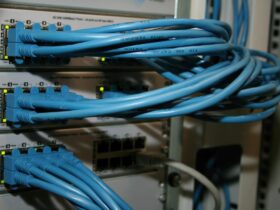As the internet has evolved and the number of connected devices continues to grow, it has become increasingly clear that the traditional IPv4 protocol is nearing depletion of its resources. This has prompted the development of a fresh standard – IPv6, which aims to tackle the challenges linked to the exhaustion of IPv4 addresses.
IPv4 and IPv6
IPv4, which was created in 1983, laid the groundwork for today’s internet. It relies on 32-bit addresses (such as 192.168.0.1), but this limits the number of available IPs to around 4.300.000.000 . Initially, this may seem like a large number, but with the surge in connected devices, such as smartphones, tablets, IoT gadgets, and more, IPv4 addresses are running out.
The depletion of IPv4 addresses brings forth various issues. One challenge is the necessity to implement NAT mechanisms, allowing multiple devices to share the same public IP address. This complexity in network setups can lead to performance and security concerns. Furthermore, IPv4 addresses are becoming more costly and harder to acquire for new organizations and service providers.
Transitioning from IPv4 to IPv6
The shift from IPv4 to IPv6 is a complex and time-consuming process because there is an extensive array of devices and infrastructure currently reliant on IPv4. Nevertheless, it is an unavoidable progression, and many organizations and service providers have already initiated the adoption of IPv6.
The transition procedure encompasses multiple phases:
1. Assessment of Existing Infrastructure: Organizations must evaluate the readiness of their current infrastructure for the transition to IPv6.
2. Preparation for IPv6: This encompasses staff training, updating network equipment, and creating a transition plan.
3. Gradual Implementation: Gradual deployment of IPv6 enables organizations to migrate a portion of their network to the new protocol progressively, without disrupting the existing infrastructure.
4. Testing and Debugging: Rigorous testing and debugging of the new infrastructure are pivotal to ensure its stability.
5. Full Transition: Following the successful implementation and debugging of IPv6, organizations can entirely transition to using the new protocol.
IPv6 Testimonials
To understand how IPv6 can be beneficial in everyday life, let’s take a look at testimonials from three different individuals.
Testimonial 1: John
“I work in the IT field, and IPv6 has been immensely helpful. We transitioned to IPv6 in our company, and it allowed us to simplify network configuration, avoid NAT complexities, and provide each device with a unique IP address. This made our network more reliable and efficient.”
Testimonial 2: Anna
“I’m a homemaker, and when we switched to IPv6 in our home, I noticed a significant improvement in the quality of connectivity for our smartphones, tablets, and IoT devices. With IPv6, we can connect more devices to the network without issues, making our everyday life more convenient.”
Testimonial 3: David
“As a network administrator at a university, I know the importance of having enough IP addresses for students and faculty. Transitioning to IPv6 allowed us to provide each user with a unique address and improved the security of our network. It also gave us more flexibility in network configuration and management.”

Successful IPv6 implementations
Here are some examples of successful IPv6 implementations:
1. Google: Google actively deploys IPv6 in its infrastructure and services. They support IPv6 on their major web services, including the search engine and YouTube. This allows millions of users to access content via IPv6 and contributes to the adoption of the new protocol.
2. Comcast: One of the largest cable internet providers in the United States, is implementing IPv6 in its network. They offer IPv6 access to their customers, which helps enhance network availability and capacity.
3. Facebook: Facebook also deploys IPv6 in its services. They provide IPv6 support on their social network, enabling millions of users to communicate via IPv6.
4. Deutsche Telekom: Deutsche Telekom, one of the largest European telecommunications operators, is actively transitioning to IPv6. They offer IPv6 to their customers and are working on modernizing their network to support the new protocol.
5. Hurricane Electric: Hurricane Electric is one of the largest global providers of IPv6 transit services. They offer IPv6 services to organizations and internet service providers, contributing to the global expansion of IPv6 availability.
6. RIPE NCC: The Regional Internet Registry for Europe, the Middle East, and several other regions, RIPE NCC actively supports the adoption of IPv6. They provide resources and training to organizations to help them transition to IPv6.
These examples illustrate successful IPv6 implementations in various domains, including web services, telecommunications, and internet service providers. They demonstrate how IPv6 is actively being deployed in networks worldwide to ensure a more resilient and scalable internet for all users.
FAQ
Can IPv6 addresses be more creative than just numbers and letters?
Yes, IPv6 addresses can contain letters, numbers, and colons. This makes them more flexible and user-friendly and allows for addresses that are easier to remember.
What are the advantages of IPv6 for IoT devices?
IPv6 is particularly beneficial for IoT devices as it provides a vast number of IP addresses and supports auto-configuration. This simplifies the connection and management of a large number of IoT devices on a network.
Are there alternative uses for IPv6 beyond networks?
Yes, IPv6 can be used not only for networks but also for creating unique identifiers on the internet, for example, as identifiers in blockchain or for resource management in the Internet of Things (IoT), such as smart contracts.


















